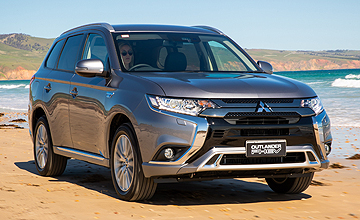
Overview
Mitsubishi introduced the plug-in hybrid version of its Outlander medium SUV in 2014, ushering in a lower entry point to PHEVs in Australia at $47,490 plus on-roads.
Over the years the price of the base Outlander PHEV grew to $50,490, however the introduction of the new ES variant has made it more affordable than ever before, at $45,990.
Can the cheaper ES lure more buyers into the Outlander PHEV range?
Drive impressions
Mitsubishi has sold approximately 2100 examples of the Outlander PHEV since it launched in 2014, however it has struggled to capture the attention of private buyers, with around 90 per cent of sales coming from fleet and business customers.
The brand hopes the new entry-level ES will attract more private buyers, with the asking price coming in under the $50,000 mark with the added allure of a cheaper fuel bill.
Australia’s slow, reluctant take-up of electrified vehicles is largely due to insufficient charging infrastructure and a lack of government incentives, however value-oriented offerings such as the Outlander PHEV should help turn the tide – eventually.
While many car buyers are sceptical of new technology such as hybrids, a drive of the Outlander PHEV should alleviate most of their fears as it is every bit as user-friendly on the road as its petrol or diesel-powered competitors.
In a relatively brief drive of the Outlander PHEV, we got to experience the capability of the plug-in hybrid powertrain, which teams an 87kW/186Nm 2.0-litre aspirated petrol engine to two electric motors, each placed on the front and rear axles, which output 60kW each.
The 12kWh battery allows for a pure EV driving range of 54km and, according to the brand, can be charged in 6.5 hours through a 10-amp household power socket.
Three driving modes are available in the Outlander PHEV – including parallel hybrid, in which the engine and electric motors work in tandem; series hybrid, where the electric motors power the wheels and the engine is used to generate energy that tops up the batteries; and EV mode, in which the petrol engine is not used at all.
Most of our driving was done in parallel hybrid mode, which worked seamlessly together to deliver the ideal output through mostly hilly and country back-road driving.
Power delivery is solid without being amazing, however we were pleasantly surprised at the vehicle’s linear acceleration from standstill to 100km/h, which did not seem to taper off the closer we got to reaching the three-figure mark.
Another nifty feature of the plug-in drivetrain is the adjustable regenerative braking, which can be set to five different strengths using the steering wheel-mounted paddle shifters.
During a drive downhill from the top of Mt Macedon in Melbourne’s north-west, the adjustable braking came in handy and allowed significant recuperation of battery power.
Tech-heads will love the multitude of read-outs on the infotainment cluster that show electric and petrol power outputs, and consumption over different distances, giving an insight into how the twin-power system works.
Despite entering the vehicle with around half of its battery capacity left, we were a bit disappointed by the PHEV’s fuel economy figure, which came out at 6.2 litres per 100km. The official combined figure is 1.7L/100km, which we suspect was achieved through using the series hybrid mode.
Some aspects of noise, vibration and harshness (NVH) as well as steering and ride settings have been adjusted, resulting in a pleasantly quiet driving experience – no doubt aided by the hybrid drivetrain.
Ride quality is comfortable and settled on 18-inch rims, although vehicle dynamics are nothing to write home about, with generally safe and boring driving characteristics. Having said that, we hardly expect Outlander PHEV buyers to be the type to throw their car into corners on the way to work in the morning.
For what is the entry-level variant, the ES has a well-equipped and comfortable interior, with just about everything needed in a car for 2018.
Our test vehicle was fitted with the optional Advanced Driver Assistance Systems (ADAS) pack, which adds forward collision mitigation, lane departure warning, adaptive cruise control, auto high beam and an electrochromatic rearview mirror for a $1500 premium.
Mitsubishi’s Smartphone Link Display Audio infotainment system works well projected on to a 7.0-inch touchscreen with Apple CarPlay and Android Auto compatibility. DAB+ digital radio is included as standard, as are Bluetooth voice commands, reversing camera, and snug seats with leatherette and microsuede trim, which proved to be very comfortable.
Head- and legroom is ample for front passengers, while rear occupants are treated to very generous levels of legroom, even for tall adults.
The cheaper Outlander PHEV may attract more private buyers, however we see the lower entry point continuing to appeal to fleet customers until appropriate levels of infrastructure and government support are available.
Nevertheless, the Outlander ES PHEV should be on the shopping list of anyone looking to purchase a hybrid vehicle without wanting to break the bank.